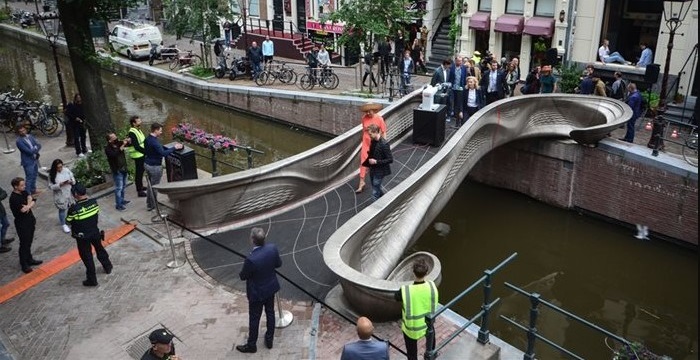Printed by four robots in just six months, the bridge marks a new beginning in additive manufacturing. Most 3D printing projects, whether they are designed for the aerospace industry or urban infrastructure, use proprietary inks or source material. This bridge, however, uses steel – a tried-and-true construction material – and is actually an experiment to test whether applications for steel can even be found in 3D printing.
“A 3D-printed metal structure large and strong enough to handle pedestrian traffic has never been constructed before,” said Professor Leroy Gardner of the Department of Civil and Environmental Engineering at Imperial College London, in a press release. “We have tested and simulated the structure and its components throughout the printing process and upon its completion, and it’s fantastic to see it finally open to the public.”

The project began in 2015 and used multi-axis robots to heat the steel to 2,732°F (1,500°C) to construct the bridge layer by layer. The bridge is 12 metres long and made of 4,500 kg of stainless steel. Considering how this engineering miracle was built, it seemed logical to include a robot in the bridge’s opening ceremony. Queen Maxima of the Netherlands pressed a green button that set the robot’s arm in motion, which cut the ribbon with a pair of scissors. The bridge is now open to pedestrians and cyclists.
Several sensors are attached to the bridge to monitor for any deformations or vibrations and track how changes in the weather affect the structure. The data collected will then be sent to a digital model – known as a digital twin – of the bridge. It will enable researchers to understand how the 3D-printed steel structure evolves with time and how it ages. This will help to spot problematic areas and decide whether any changes or maintenance might be needed. Also, anything learnt from this model can be used for larger construction projects in the future.
The bridge was constructed through joint efforts of MX3D – a Dutch start-up focusing on 3D metal printing – researchers from Imperial College London and The Alan Turing Institute.
“3D printing is poised to become a major technology in engineering and we need to develop appropriate approaches for testing and monitoring to realise its full potential,” said Professor Mark Gilorami from the Alan Turing Institute, who led the project.
The 3D-printed bridge will remain in place in Amsterdam for two years, while the original bridge is being renovated.
* According to an Imperial College London press release
